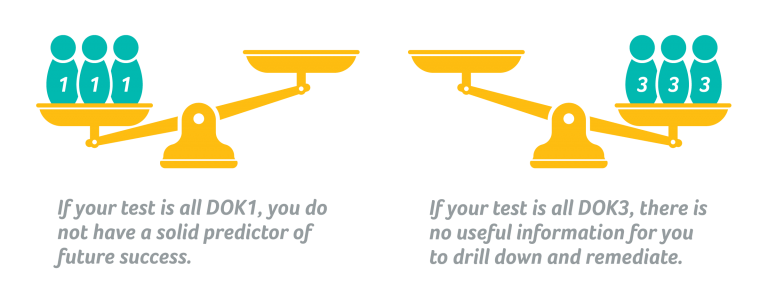If you are building instruction using a cognitive complexity model, consider aligning your tests and quizzes with the complexity levels you’re teaching.
There are three main cognitive complexity models in use today:
While an exhaustive discussion of the different complexity models is beyond the scope of this post, here are some general guidelines for connecting each model to the development of exam items:
Single Response: Multiple Choice, True/False
Students select one and only one of the available answer choices. Single response questions easily accommodate automated scoring.
Maps to:
- Webb: DOK 1, 2, 3
- Bloom: L1, L2, L3
- Marzano: Retrieval, Comprehension, Knowledge
Multiple Response: Multiple Choice, Matching, Drag-and-Drop, Color In, etc.
Students select all that apply of the available answer choices. Single response questions easily accommodate automated scoring, although you need to use scoring methods that ensure students don’t just select all choices every time in the hopes of getting full credit.
Maps to:
- Webb: DOK 1, 2, 3
- Bloom: L1, L2, L3, L4
- Marzano: Retrieval, Comprehension, Knowledge, Analysis, possibly Utilization (depending on how you construct the question stem)
Constructed Response: Gridded, Fill-in, Essay
Students fill in an appropriate number(s), word, or phrase, or write an essay in response to a prompt. Fill-in can accommodate automated scoring, although you may need to review the scoring for consistency (e.g., student responses may be synonyms that are correct, but not (yet) in the allowed responses list). Essay responses are not good candidates for automated scoring beyond grammar and plagiarism checking.
Maps to:
- Webb: DOK 1, 2, 3. possibly 4 (depending on how you construct the question stem)
- Bloom: L1, L2, L3, L4, L5, L6
- Marzano: Retrieval, Comprehension, Knowledge, Analysis, possibly Utilization (depending on how you construct the question stem)
Performance-Based Assessments (PBAs)
Students complete a multi-stage project (developing an essay or short story, creating a small-scale engineering project, preparing and delivering a presentation, etc.). In the higher education world, we often call these “assignments.” If you assign them in stages (i.e., different segments or aspects are due at different times, building up to a final version), you can count each score towards a collective final score as an assessment.
Maps to:
- Webb: DOK 4
- Bloom: L3, L4, L5, L6
- Marzano: Knowledge, Analysis, Utilization
Remember, balance is key!


Social
View our latest posts or connect with us below on Social Media.